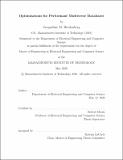Optimizations for performant multiverse databases
Author(s)
Bredenberg, Jacqueline M.
Download1192539336-MIT.pdf (1.852Mb)
Other Contributors
Massachusetts Institute of Technology. Department of Electrical Engineering and Computer Science.
Advisor
Robert Morris.
Terms of use
Metadata
Show full item recordAbstract
Modern web applications store data in backend databases, and access it through a variety of frontend queries. User permissions are implemented by checks on those queries, but a maliciously injected (or simply buggy) query can easily leak private data. Multiverse databases attempt to prevent these data leaks by creating a separate view of the database contents (or "universe") for each user, and enforcing in the backend that this universe contains only data that the user is allowed to query. These views are precomputed and materialized using a streaming dataflow system so that queries return promptly. This design is difficult to make efficient. A simple approach makes copies of data and operators for each universe, but state size that increases proportionally to the number of users quickly becomes impractical. In this work, we developed optimizations for multiverse dataflow graphs, which aim to reuse the same computations (i.e. dataflow subgraphs) in many different universes while maintaining security invariants. We evaluate these optimizations in the context of the HotCRP and Piazza web applications. The resulting graphs are about 2x more space-efficient and 3x more computation-efficient than the naïve ones. Graph size and processing time still scale linearly with the number of users, so our design may still not be efficient enough to be practical, but our optimizations make progress toward making multiverse databases a feasible solution to web application security.
Description
Thesis: M. Eng., Massachusetts Institute of Technology, Department of Electrical Engineering and Computer Science, May, 2020 Cataloged from the official PDF of thesis. Includes bibliographical references (pages 63-64).
Date issued
2020Department
Massachusetts Institute of Technology. Department of Electrical Engineering and Computer SciencePublisher
Massachusetts Institute of Technology
Keywords
Electrical Engineering and Computer Science.